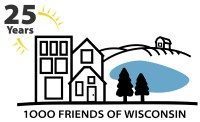Green Tier Legacy Communities (GTLC)
The Green Tier Legacy Communities Charter is a unique partnership between Wisconsin communities, non-profit organizations, and state agencies. We work together to assist communities in developing and implementing sustainability measures.
When communities sign the Green Tier Legacy Communities charter, they agree to take actions and share information to move continuously toward a future that promotes environmental stewardship, economic growth, public health, and social equity.
All of the recommended policies and programs in GTLC are administered at the local level and require little in the way of new state statutes or funding. GTLC allows communities to collaborate and share strategies with each other and encourages communities to adopt better practices through education, public involvement and finally, implementation.
Legacy Communities are a leading example for combating climate change at the local level.
Currently, over 30 communities and counties across the state have signed the charter and are actively participating.
Learn more about Green Tier Legacy Communities.
To become a Green Tier Legacy Community, visit the DNR Green Tier website.
Legacy Community Alliance for Health (LCAH)
Green Tier communities are participating in Legacy Community Alliance for Health (LCAH) – a project to build capacity within participating municipalities to improve health and health equity through the use of data and evidence-informed policies. The goal is to help communities achieve gains in at least one of four policy areas of interest: clean water, active transportation, safe and affordable housing, and/or healthy and affordable local food systems. Each participating community will choose its own policy approach.
History of Green Tier Legacy Communities
Green Tier Legacy Communities are a direct result of the 2008 recommendations of the Transportation Working Group (TWG) of Governor Doyle’s Global Warming Task Force (GWTF.)
Led by 1000 Friends of Wisconsin, the working group identified several measures that would reduce carbon emissions from the transportation sector – currently the largest source of greenhouse gas emissions in the U.S. Among the recommendations were: reduced reliance on the automobile; increased transit options; traditional neighborhood design ordinances to increase housing density and better opportunities to develop local amenities such as grocery stores and shopping; local programs to encourage walking and transit; and better bicycling infrastructure to encourage bicycle commuting.
All of the recommended policies and programs are administered at the local level and require little in the way of new state statutes or funding. But, what was needed was a way to encourage communities to adopt these better practices through education, public involvement and finally, implementation. 1000 Friends of Wisconsin took the lead on implementing these recommendations by working with local units of government across the state.
Rather than work with communities one at a time (there are over 1700 units of local government in Wisconsin), 1000 Friends looked for a model that would allow communities to collaborate and share strategies with each other. 1K found what seemed to be an ideal program administered by the Wisconsin Department of Natural Resources – the Green Tier Program. Green Tier was designed to allow business entities to implement best environmental practices and in turn, receive technical assistance from the Wisconsin DNR to refine and improve those management policies. Frequently businesses would have their trade associations create a charter that would proscribe best management policies for association members who wanted to participate in a narrowly focused Green Tier Charter tailored to that trade.
1K took this model and proposed to the DNR that a charter be created for municipalities who wanted to implement best environmental management practices at the local level and receive technical assistance in return. Then DNR Secretary Matt Frank enthusiastically endorsed the idea and designated a staff person to work full time with 1K to create a charter for interested municipalities. 1K then approached the Wisconsin Counties Association and Wisconsin League of Municipalities to see if their local government members would be interested in such a charter. Five communities quickly registered their interest in forming a charter and the work to create the charter began.
In December of 2010, the partners and 5 communities created the inaugural charter for what was called The Wisconsin Green Tier Legacy Community program.
The charter listed scores of best management practices for communities that included model zoning ordinances, best management practices for everything from transportation improvements to municipal solar energy programs to wastewater management. Each community was to come up with their own baseline measure of energy use (thus greenhouse gas emissions) and pledge to make continuous improvements over the life of their participation in the program.
Today there are many communities and counties across the state signed on to the charter and the list continues to grow. During quarterly meetings the communities share successes and ideas for new opportunities.
